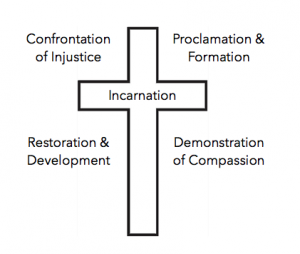By Leeann Younger, co-planting pastor of Cityview Covenant Church in Pittsburgh, PA. She is a proud wife, adoring mother and currently obsessed with being in “the room where it happens”.
In Where the Cross Meets the Streets Noel Castellanos shares his life story in an unassuming, conversational style. His tale worms its way into your consciousness. Before you are fully aware of what’s happening the story captivates your imagination, shaping what you think is possible in the world around you. The implications of Castellanos’ story will challenge some of your fundamental assumptions about how you live your life with Jesus. You will be, because of the truth inherent in this book, forced to question whether your vision of God and his Kingdom is big enough. You’ll be forced to consider if you’ve settled for a convenient Gospel, one that fits your schedule and accommodates your priorities. If you are comfortable and content in the life you currently live, if you don’t want to be invited to deeper waters in Jesus name, then don’t read this book. You have been warned.
Castellanos is currently president and CEO of the Christian Community Development Association (CCDA). For the uninitiated, CCDA is an organization, founded by John Perkins, committed to raising up leaders living out the call of the gospel in socioeconomically challenged neighborhoods across the country. This memoir is partly about how Castellanos found himself at the helm of this great organization. That said, this story is also part Bible study and part loving critique of the ways our understanding of the Gospel short-changes both God and those He loves.
Castellanos explores in the telling of his own story, a key question: “What happens when God is at the center of a neighborhood?” As he navigates the stages of his own life story Castellanos unfolds how his understanding of the Gospel grew in response to those he was called to serve in the different barrios where he lived. His path eventually leads him to the CCDA and the core principles of returning and reinvesting in poor neighborhoods.
It’s this practice of returning and reinvesting that God used to expand Castellanos’ understanding of what God could do in the center of a neighborhood full of urban challenges. According to Castellanos, we can (and should) expect God to care and address the full range of human needs. In sharing about starting a new, urban work within a classically evangelical organization he writes “The more I observed [the] dynamics in my barrio, the more I struggled with only attracting young people to a club meeting and getting them to camp.”
He anchors his expanded view of God’s mission for us in scripture. Through exploring passages about Ezra & Nehemiah, the good Samaritan, the call of the disciples and others he paints a picture of a God who is fully invested in the life of His creation. Castellanos tells of his own experience as a classic ‘evangelico’ who, in ministering to suffering families came to understand that proclamation of the gospel and spiritual formation are only a part of the work encompassed in the incarnation.
Those familiar with Castellanos or the CCDA will recognize this simple diagram as a crystallization of his teaching about the depth of the incarnation. Compassion, restoration, development and confronting injustice are not additional, optional ministry activities. They are essential to faithfully living the gospel.
Maybe it’s because I’ve been a church planter working for 6 years in a socioeconomically challenged community but I felt as if Castellanos followed me around, telling my ministry story in this book. I’m a product of classic evangelical ministry so the primary tools in my toolbox focus on strategies for proclamation and spiritual formation. In the last 6 years the reality of living out the call of the incarnation has led our congregation to expressions of mercy. We are just beginning to understand the work of restoration in our community.
Reading this book deepened my desire to gain the skills needed to challenge the injustices experienced by my neighbors and those in my congregation. Like Castellanos, I’ve lamented that the very good work of proclamation, formation and mercy ministries can seem to have limitations in a neighborhood full of long-term challenges. I know faithful Christ-followers who haven’t yet gained the skills necessary to get a job. In this context spiritual formation must expand to include individual and community development and restoration. I’ve seen dozens of people respond to the freedom promised in the gospel. I’ve also seen the same people struggle to find freedom from sin-soaked, inequitable systems involving law enforcement, education, health care and housing. The invitation to life in God’s Kingdom is an invitation to a family that is mobilized to care passionately about the life that we live right here and now.
In this book Castellanos offers us a picture of a full expression of the Gospel in his specific context. Perhaps the best thing about this book is that he resists offering a roadmap to a one-size-fits-all expression of the incarnation. The key question for the reader is “what happens when God is at the center of YOUR neighborhood?” Urban, suburban and rural readers alike will find a compelling gospel-centered reason to do the very hard work of fully living the incarnation in their specific context. By weaving the theological implications of the incarnation through his own personal story, Castellanos invites us to take the journey with Jesus, trusting him to bring the fullness of His life to bear-through us- in our neighborhoods. Wherever you live, whatever your role in building God’s kingdom this book paints a picture of loving a community in the way that God has loved us. As Jesus said, “go and do likewise”.



